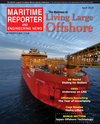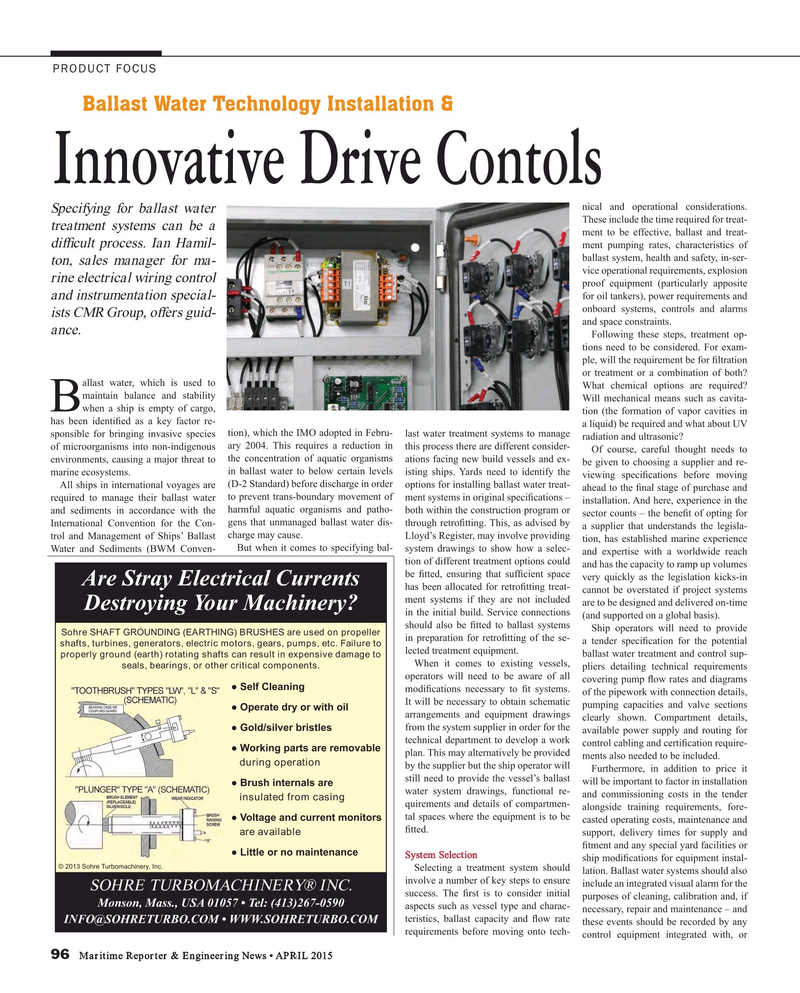
Page 96: of Maritime Reporter Magazine (April 2015)
Offshore Edition
Read this page in Pdf, Flash or Html5 edition of April 2015 Maritime Reporter Magazine
PRODUCT FOCUS
Ballast Water Technology Installation &
Innovative Drive Contols nical and operational considerations.
Specifying for ballast water
These include the time required for treat- treatment systems can be a ment to be effective, ballast and treat- dif? cult process. Ian Hamil- ment pumping rates, characteristics of ballast system, health and safety, in-ser- ton, sales manager for ma- vice operational requirements, explosion rine electrical wiring control proof equipment (particularly apposite for oil tankers), power requirements and and instrumentation special- onboard systems, controls and alarms ists CMR Group, offers guid- and space constraints.
ance.
Following these steps, treatment op- tions need to be considered. For exam- ple, will the requirement be for ? ltration or treatment or a combination of both? allast water, which is used to
What chemical options are required? maintain balance and stability
Will mechanical means such as cavita-
B when a ship is empty of cargo, tion (the formation of vapor cavities in has been identi? ed as a key factor re- a liquid) be required and what about UV last water treatment systems to manage radiation and ultrasonic?
sponsible for bringing invasive species tion), which the IMO adopted in Febru- of microorganisms into non-indigenous ary 2004. This requires a reduction in this process there are different consider-
Of course, careful thought needs to environments, causing a major threat to the concentration of aquatic organisms ations facing new build vessels and ex- be given to choosing a supplier and re- in ballast water to below certain levels isting ships. Yards need to identify the viewing speci? cations before moving marine ecosystems.
All ships in international voyages are (D-2 Standard) before discharge in order options for installing ballast water treat- ahead to the ? nal stage of purchase and required to manage their ballast water to prevent trans-boundary movement of ment systems in original speci? cations – installation. And here, experience in the both within the construction program or sector counts – the bene? t of opting for and sediments in accordance with the harmful aquatic organisms and patho- gens that unmanaged ballast water dis- through retro? tting. This, as advised by a supplier that understands the legisla-
International Convention for the Con- trol and Management of Ships’ Ballast charge may cause. Lloyd’s Register, may involve providing tion, has established marine experience
But when it comes to specifying bal- Water and Sediments (BWM Conven- system drawings to show how a selec- and expertise with a worldwide reach tion of different treatment options could and has the capacity to ramp up volumes be ? tted, ensuring that suf? cient space very quickly as the legislation kicks-in $UH6WUD\(OHFWULFDO&XUUHQWV has been allocated for retro? tting treat- cannot be overstated if project systems ment systems if they are not included are to be designed and delivered on-time 'HVWUR\LQJ Ship operators will need to provide Sohre SHAFT GROUNDING (EARTHING) BRUSHES are used on propeller in preparation for retro? tting of the se- a tender speci? cation for the potential shafts, turbines, generators, electric motors, gears, pumps, etc. Failure to lected treatment equipment. ballast water treatment and control sup- properly ground (earth) rotating shafts can result in expensive damage to When it comes to existing vessels, pliers detailing technical requirements seals, bearings, or other critical components. operators will need to be aware of all covering pump ? ow rates and diagrams ?6HOI&OHDQLQJ modi? cations necessary to ? t systems. of the pipework with connection details, It will be necessary to obtain schematic pumping capacities and valve sections ?2SHUDWHGU\RUZLWKRLO arrangements and equipment drawings clearly shown. Compartment details, from the system supplier in order for the available power supply and routing for ?*ROGVLOYHUEULVWOHV technical department to develop a work control cabling and certi? cation require- ?:RUNLQJSDUWVDUHUHPRYDEOH plan. This may alternatively be provided ments also needed to be included. during operation by the supplier but the ship operator will Furthermore, in addition to price it still need to provide the vessel’s ballast will be important to factor in installation ?%UXVKLQWHUQDOVDUH water system drawings, functional re- and commissioning costs in the tender insulated from casing quirements and details of compartmen- alongside training requirements, fore- tal spaces where the equipment is to be casted operating costs, maintenance and ?9ROWDJHDQGFXUUHQWPRQLWRUV ? tted. are available support, delivery times for supply and ? tment and any special yard facilities or ?/LWWOHRUQRPDLQWHQDQFH System Selection ship modi? cations for equipment instal- © 2013 Sohre Turbomachinery, Inc. Selecting a treatment system should lation. Ballast water systems should also involve a number of key steps to ensure include an integrated visual alarm for the SOHRE TURBOMACHINERY® INC. success. The ? rst is to consider initial purposes of cleaning, calibration and, if 0RQVRQ0DVV86$?7HO aspects such as vessel type and charac- necessary, repair and maintenance – and teristics, ballast capacity and ? ow rate these events should be recorded by any ,1)2#62+5(785%2&20?:::62+5(785%2&20 requirements before moving onto tech- control equipment integrated with, or 96 Maritime Reporter & Engineering News • APRIL 2015 MR #4 (90-97).indd 96 MR #4 (90-97).indd 96 4/2/2015 9:56:50 AM4/2/2015 9:56:50 AM

 95
95

 97
97
